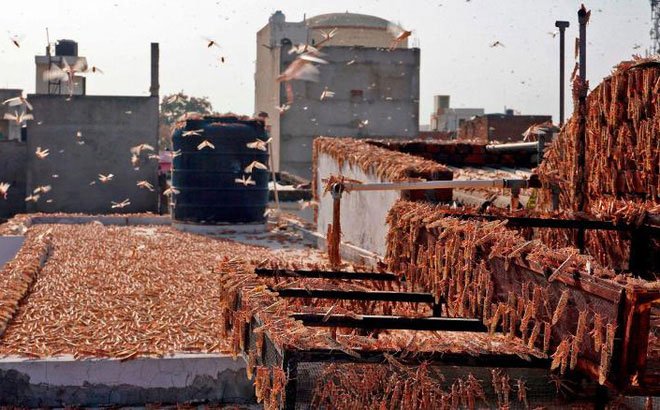Grasshoppers cover up the sky, flying like a storm, leaving 23 countries with hunger
Favorable weather, loose surveillance of crops, especially in war zones, and the challenges caused by the Covid-19 pandemic caused the locust crisis.
Covid-19 "helped" the locusts to reproduce like never before
Suddenly the sky was darkening at Michael Gatiba's 4-hectare farm in Nakuru, Kenya, he was stunned to realize the appearance of millions of Europeans. "It's like a storm," said Gatiba, 45, speaking over the phone. "They cover everything".
That's what happened 3 months ago. Although Mr. Gatiba said that he was very lucky because the damage from insects was very small, he worried that locusts that were raging all over Africa, the Middle East and Asia in the past two years would return to waning. breaking his crop.
When the grasshopper began to resume in the second half of June, experts warned that, if countries did not continue to receive assistance to stop this pest, millions of people in at least 23 countries fell into. food shortages by the end of this year. "We can't do anything. Grasshoppers don't breed here but they can appear anytime," says Gatiba. A crop failure could put Gatiba and his four children in need.
 If not stopped, millions of people in at least 23 countries will suffer from food shortages by the end of this year.
If not stopped, millions of people in at least 23 countries will suffer from food shortages by the end of this year.
According to the Food and Agriculture Organization of the United Nations (FAO), desert grasshoppers are a pest of the grasshopper family. With only 3 months of age, but in the right environment, this pest can even increase the population by 20 times and move in huge swarms to devastate crops.
According to experts, favorable weather, loose crop surveillance - especially in conflict areas - and the challenges of accessing resources due to the COVID pandemic have caused the crisis. grasshoppers when the insect reaches an unprecedented scale in decades. "Even my grandfather has never witnessed anything like this," Gatiba said.
450 billion grasshoppers were killed
Grasshoppers are destroying crops and growing in Kenya, Ethiopia, Somalia and Djibouti. It is expected that they will begin to relocate their area of activity when the wind reverses later this month and some will fly to Sudan. Melissa Williams, a senior World Bank agricultural development expert, said there were fears that insects could penetrate deeper into West Africa and cause harm in some of the world's poorest countries.
At the same time, other grasshoppers in recent weeks are devastating crops in India and Pakistan, especially in the provinces of Punjab and Sindh and surrounding areas.
However, international agencies and local governments are making significant progress. "Since the beginning of this year, we have destroyed about 450 billion grasshoppers," said Cyril Ferrand, head of FAO's recovery team in East Africa.
Pesticide spraying is the most effective way to control desert grasshoppers and countries familiar with this pest such as Sudan and Eritrea are implementing large-scale pesticide programs to control insect reproduction. this coincide. However, monitoring and spraying of pesticides was not implemented in remote areas of the Arabian Peninsula in 2018, especially the war-torn Yemen.
After many heavy rains, two tropical storms from the Indian Ocean formed a lush vegetation, helping grasshoppers grow and multiply. "Normally, the first line of defense for locusts is Yemen," said Ms Williams. But "because there is a war there, it is very difficult to access and deploy pest control. Because of that, everything is out of control."
Implementing pesticide spraying campaigns in peaceful areas also did not work immediately. Many countries currently under attack by these insects have for years not been in direct contact with grasshoppers and do not have the expertise to deal with the pest, Mr. Ferrand said. The last locust outbreak was in Kenya 70 years ago, while the last time it was seen in Uganda 60 years ago.
The COVID pandemic is another challenge. Mr Ferrand said countries had sent the experts and equipment needed to kill locusts before they closed the border. FAO has also ordered equipment, including pesticides, in batches instead of on a single order in case the shipment was interrupted by disease.
In addition to focusing on mitigating damage caused by locusts, agencies and governments are working to address urgent concerns about food shortages.
While FAO extended the time to receive funding to call for contributions from governments and people around the world to ensure that they can maintain their victory against the outbreak of locusts, whenever they look up, In the sky, farmers like Mr. Gatiba feel insecure again. The loss of a large maize harvest in the next two months could prevent his family from paying the tuition for their four children.
- Israeli army blocked
- 'Grasshopper Clouds' rises in the Middle East
- Stressed crocodiles and ... hunger strikes
- Hundreds of millions of grasshoppers 'attack' Africa, destroying crops
- Simulation of aerodynamic secrets of grasshoppers
- 5 things that hunger reveals the truth about the body
- 'Terrific grasshopper storm' blind sky during the day in India
- Video: The culprit causes humanity to still suffer from hunger
- The locust's love changes because of the noise
- To control hunger, jump rope
- Millions of grasshoppers are as big as sparrows attacking Russia
- Humans are about war because the food?
 Why do potatoes have eyes?
Why do potatoes have eyes? 'Tragedy' the world's largest carnivorous life: Death becomes ... public toilet
'Tragedy' the world's largest carnivorous life: Death becomes ... public toilet Tomatoes were once considered 'poisonous' for 200 years
Tomatoes were once considered 'poisonous' for 200 years Detecting microscopic parasites on human face
Detecting microscopic parasites on human face